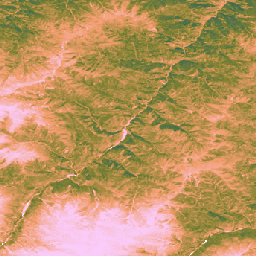
- בעלי הקטלוג
- Global Pasture Watch
- זמינות קבוצת הנתונים
- 2000-01-01T00:00:00Z–2024-01-01T00:00:00Z
- ספק קבוצת הנתונים
- Land and Carbon Lab Global Pasture Watch
- יצירת קשר
- Land & Carbon Lab
- קצב
- שנה אחת
- תגים
תיאור
מערך הנתונים הזה מספק נתונים גלובליים לא מכוילים של פרודוקטיביות ראשונית ברוטו (GPP) שמבוססת על נתוני EO משנת 2000, ברזולוציה מרחבית של 30 מ'. מערך הנתונים הנוכחי, שנוצר על ידי יוזמת Land & Carbon Lab Global Pasture Watch, מספק ערכים של פרודוקטיביות ראשונית ברוטו (GPP) ברחבי העולם ברזולוציה מרחבית של 30 מ' משנת 2000 ואילך. ערכי ה-GPP מחושבים באמצעות גישה של יעילות שימוש באור (LUE), שבה נתוני GLAD Landsat ARD (אוסף 2) נצברים כל חודשיים (Consoli et al., 2024) ושולבו עם נתוני טמפרטורה של MODIS ברזולוציה של קילומטר אחד ועם נתוני קרינה פוטוסינתטית פעילה (PAR) של CERES ברזולוציה של מעלה אחת.
כדי לשמור על גמישות של מערך הנתונים, היעילות המקסימלית של השימוש באור (LUEmax) מוגדרת ל-1 gC/m²/day/MJ עבור כל סוגי כיסוי הקרקע, וכך המשתמשים יכולים לכייל את ערכי ה-GPP בהתאם למפות ספציפיות של כיסוי הקרקע או לתנאים אזוריים.
ערכי הפרודוקטיביות הראשונית הכוללת (uGPP) הלא מכוילת, שמתעדכנים אחת לחודשיים (זמינים ב-OpenLandMap STAC), מחושבים כממוצע לפי כל שנה ומצטברים על פני תקופה מלאה של 365 ימים כדי ליצור ערכי uGPP שנתיים גלובליים, שמבוטאים ביחידות של gC/m²/year.
ערכי Grassland GPP מחושבים תוך כדי תנועה באמצעות GEE App.
מגבלות:
אי התאמה ברזולוציית נתוני הקלט: מערך הנתונים מסופק ברזולוציה של 30 מ', אבל משתני הקלט העיקריים של הטמפרטורה (MOD11A1) ושל קרינה פעילה פוטוסינתטית (CERES PAR) נגזרו ממוצרים גסים בהרבה (1 ק"מ ו-~111 ק"מ, בהתאמה). הצגת המידע הזה בקנה מידה קטן יותר עלולה להוביל לחוסר ודאות, והיא לא תמיד משקפת את התנאים המיקרו-אקלימיים בקנה מידה קטן שמשפיעים על הפרודוקטיביות של הצמחים.
ארטיפקטים של נתונים: מערך הנתונים מכיל ארטיפקטים ויזואליים מוכרים, כולל פסים אנכיים ('אפקט הפסים') באזורים מסוימים, שהם תוצאה של בעיות בחיישן Landsat 7 (כשל בתיקון קו הסריקה) ובתהליך מילוי הפערים ששימש ליצירת ארכיון ההחזרות הבסיסי (Consoli et al., 2024). הארטיפקטים האלה עלולים לשבש את הרציפות המרחבית של הערכות ה-GPP במהלך תקופות של כיסוי עננים ושלג
רזולוציה זמנית: הנתונים נוצרים ברזולוציה זמנית של פעמיים בחודש. יכול להיות שפרק הזמן הזה לא מספיק כדי לתעד תקופות צמיחה חשובות או תגובות מהירות של צמח לשינויים סביבתיים (כמו גשם חזק), ולכן קשה לתעד במדויק את שיאי הפרודוקטיביות ואת השינויים העונתיים.
כיול של שטחי עשב: ערכי ה-GPP של שטחי עשב מחושבים באמצעות פרמטר יחיד של יעילות מקסימלית של ניצול אור (LUEmax) (0.86 gC/m²/year/MJ) לכל שטחי העשב בעולם, על סמך אלגוריתם MOD17. הערך הזה לא מותאם לסוגים ספציפיים של שטחי עשב או לתנאים מקומיים. כתוצאה מכך, המודל מראה נטייה להערכת חסר של GPP בהשוואה למדידות של מגדל שטף קרקעי.
תלות ברמת הדיוק של מפות שטחי העשב: רמת הדיוק של ערכי ה-GPP של שטחי העשב תלויה ברמת הדיוק של מפות שטחי העשב של GPW שמשמשות כבסיס. כל סיווג שגוי של כיסוי הקרקע במפות המקור (למשל, אם שטחי שיחים או שטחים חקלאיים מזוהים כשטחי עשב) יוביל לשגיאות תואמות בהערכות של GPP עבור המיקומים האלה.
מידע נוסף זמין במאמר Isik et. al, 2025, Zenodo ובאתר Global Pasture Watch GitHub
תחום תדרים
רצועות
| שם | מינימום | מקסימום | גודל הפיקסל | תיאור |
|---|---|---|---|---|
gc_m2 |
0 | 4000 | 30 מטרים | גרמים של פחמן למטר רבוע בשנה (gC/m²/year) |
מאפייני תמונה
מאפייני תמונה
| שם | סוג | תיאור |
|---|---|---|
| גרסה | INT | גרסת המוצר |
תנאים והגבלות
תנאים והגבלות
ציטוטים ביבליוגרפיים
Isik, M. S., Mesquita, V., Parente, L., & Consoli, D. (2025). Global Pasture Watch – קוד המקור של מפות ה-GPP הגלובליות הלא מכוילות שמבוססות על נתוני EO ומפות ה-GPP של שטחי העשב ברזולוציה של 30 מ'. Zenodo. [Source code]. Zenodo doi:https://doi.org/10.5281/zenodo.15675358
Isik MS, Parente L, Consoli D, et al. (2025). יעילות השימוש באור (LUE) על בסיס פרודוקטיביות ראשונית ברוטו (GPP) דו-חודשית של שטחי עשב גלובליים ברזולוציה מרחבית של 30 מ' (2000–2022), PeerJ. doi: https://doi.org/10.7717/peerj.19774
מספרי DOI
סיור עם פלטפורמת Earth Engine
Code Editor (JavaScript)
Map.setCenter(-49.265188, -16.602052, 4); var ugppVis = {min: 0, max: 4000, palette: "faccfa,f19d6b,828232,226061,011959"} var ugpp = ee.ImageCollection( "projects/global-pasture-watch/assets/ggpp-30m/v1/ugpp_m" ) var ugpp2024 = ugpp.filterDate('2024-01-01', '2025-01-01').first(); Map.addLayer(ugpp2024, ugppVis, 'Uncalibrated GPP (2024)'); var ugpp2000 = ugpp.filterDate('2000-01-01', '2001-01-01').first(); Map.addLayer(ugpp2000, ugppVis, 'Uncalibrated GPP (2000)');

